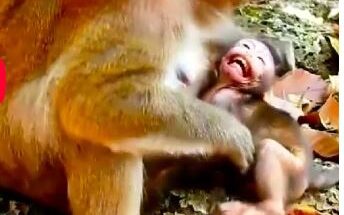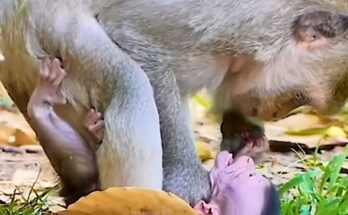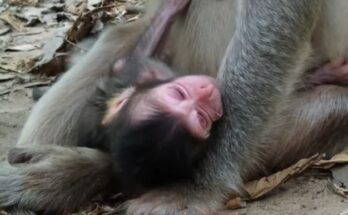In the complex social world of monkey troops, dominance and hierarchy are central to survival—but sometimes, that hierarchy turns brutal. Among many monkey species, especially those with strict social rankings like baboons, macaques, and mandrills, the bigger, stronger individuals often assert their power through relentless bullying of the weaker, smaller troop members. These displays of aggression are not random acts of violence; they serve social functions, but they can also expose the harsh realities of life in the wild.
Dominance hierarchies are a natural part of monkey societies. High-ranking individuals, usually the largest and most powerful males (and sometimes females), enjoy better access to food, mates, and resting spots. However, the way they maintain this status often involves intimidation, threats, and outright aggression toward subordinates. Smaller or lower-ranking monkeys may be chased, bitten, or slapped simply for being in the wrong place at the wrong time. Even when there’s no real competition for resources, dominant monkeys may harass others just to reinforce their position.
Younger or physically weaker monkeys, particularly adolescent males or recently weaned juveniles, are often frequent targets. These individuals are testing boundaries, learning social cues, and trying to establish their place in the troop—but they’re also vulnerable. They may be shoved aside during feeding, denied access to grooming partners, or used as scapegoats when tensions rise in the group. This constant bullying can lead to chronic stress, which affects both mental and physical health.
Food is one of the most common sources of conflict. In competitive feeding situations, dominant monkeys often monopolize the best fruit trees or feeding spots. They may aggressively displace smaller monkeys, who must wait until the bigger ones are finished—or risk a violent confrontation. This creates a constant sense of insecurity for the lower-ranking individuals, forcing them to be more cautious, opportunistic, and sometimes even deceptive just to survive.
Interestingly, this bullying behavior isn’t always unchecked. In some troops, alliances and coalitions can offer protection. A lower-ranking monkey might form bonds with others to gain strength in numbers, or find protection from a higher-ranking ally who intervenes during conflicts. In rare cases, a coalition of younger males can challenge an older dominant male, leading to a dramatic power shift in the troop. Still, these are the exceptions. Most of the time, the social order is enforced through fear and submission.
There is also a psychological toll. Studies have shown that bullied monkeys often exhibit signs of depression and social withdrawal. They may isolate themselves from the group or display submissive body language in hopes of avoiding further attacks. For these individuals, daily life is a balancing act between staying close enough to benefit from the group and avoiding the wrath of the more dominant members.
While monkey troops can be places of nurturing and cooperation, they are equally arenas of harsh social control. The powerful often show no mercy, and the weaker must navigate a minefield of bullying and aggression just to survive. It’s a sobering look at the darker side of primate society—one that mirrors some troubling aspects of our own. Would you like to pair this with photos or footage for an article or documentary?


